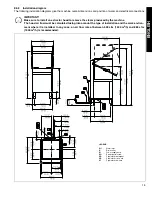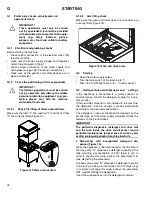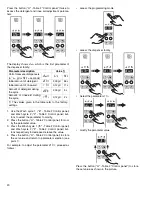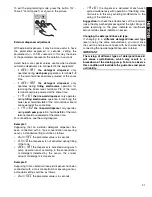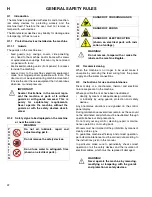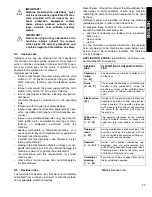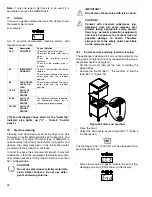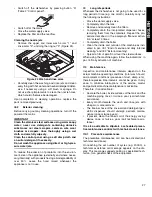
12
D
TRANSPORT, HANDLING AND STORAGE
D1
Introduction
Transport (i.e. transfer of the machine from one place to
another) and handling (i.e. transfer inside workplaces)
must occur with the use of special equipment of ade-
quate capacity.
The machine must only be transported, handled and
stored by qualified personnel, who must have:
-
specific technical training and experience;
-
knowledge of the safety regulations and applicable
laws in the relevant sectors;
-
knowledge of the general safety provisions;
-
the ability to recognize and avoid any possible haz-
ard.
D1.1
Transport: Instructions for the carrier
D2
Handling
Arrange a suitable area with flat floor for machine
unloading and storage operations.
D2.1
Procedures for handling operations
For correct and safe lifting operations:
•
use the type of equipment most suitable for charac-
teristics and capacity (e.g. lift trucks or electric pallet
truck);
•
cover sharp edges;
•
check the forks and lifting procedures according to
the instructions given on the packing.
Before lifting:
•
send all operators to a safe position and prevent per-
sons from accessing the handling zone;
•
make sure the load is stable;
•
make sure no material can fall during lifting, and
manoeuvre vertically in order to avoid impacts;
•
handle the machine, keeping it at minimum height
from the ground.
D2.2
Translation
The operator must:
•
have a general view of the path to be followed;
•
stop the manoeuvre in case of hazardous situations.
D2.3
Placing the load
Before placing the load make sure the path is free and
that the floor is flat and can take the load.
D3
Storage
The machine and/or its parts must be stored and pro-
tected against damp, in a non-aggressive place free of
vibrations and with room temperature of between -
10°C / 14°F and 50°C / 122°F.
The place where the machine is stored must have a flat
support surface in order to avoid any twisting of the
machine or damage to the support feet.
WARNING!
Do not stand under suspended loads
during the loading/unloading phases.
Unauthorized personnel must not access
the work zone.
IMPORTANT!
The machine’s weight alone is not suffi-
cient to keep it steady.
The transported load can shift:
-
when braking;
-
when accelerating;
-
in corners;
-
on particularly rough roads.
CAUTION!
For machine lifting, do not use movable
or weak parts such as casings, electrical
raceways, pneumatic parts, etc., as
anchoring points.
IMPORTANT!
Machine positioning, installation and dis-
assembly must be carried out by a spe-
cialized technician.
IMPORTANT!
Do not make modifications to the parts
supplied with the machine. Any missing
or faulty parts must be replaced with
original parts.

















